NUR3101: Primary Healthcare Strategy Comparison Report
VerifiedAdded on 2023/04/25
|12
|3650
|369
Report
AI Summary
This report provides a comparative analysis of primary healthcare strategies in Australia and India, fulfilling the requirements of a NUR3101 assignment. It begins by defining primary healthcare and its core principles, emphasizing the importance of promotive, preventive, curative, rehabilitative, and supportive services. The report then contrasts the healthcare systems of Australia and India, focusing on accessibility, equity, and social justice. It highlights the challenges faced by India, such as limited primary healthcare centers, insufficient healthcare investment, and inequities in service delivery. In contrast, the report examines Australia's approach, including its universal care services and funding models, while also acknowledging existing inequalities. The analysis delves into the determinants of health, including historical and socioeconomic factors, and the roles of healthcare professionals, particularly nurses, in addressing these issues. The report concludes by summarizing the key differences and similarities between the two countries' primary healthcare strategies and their impact on community and population health.
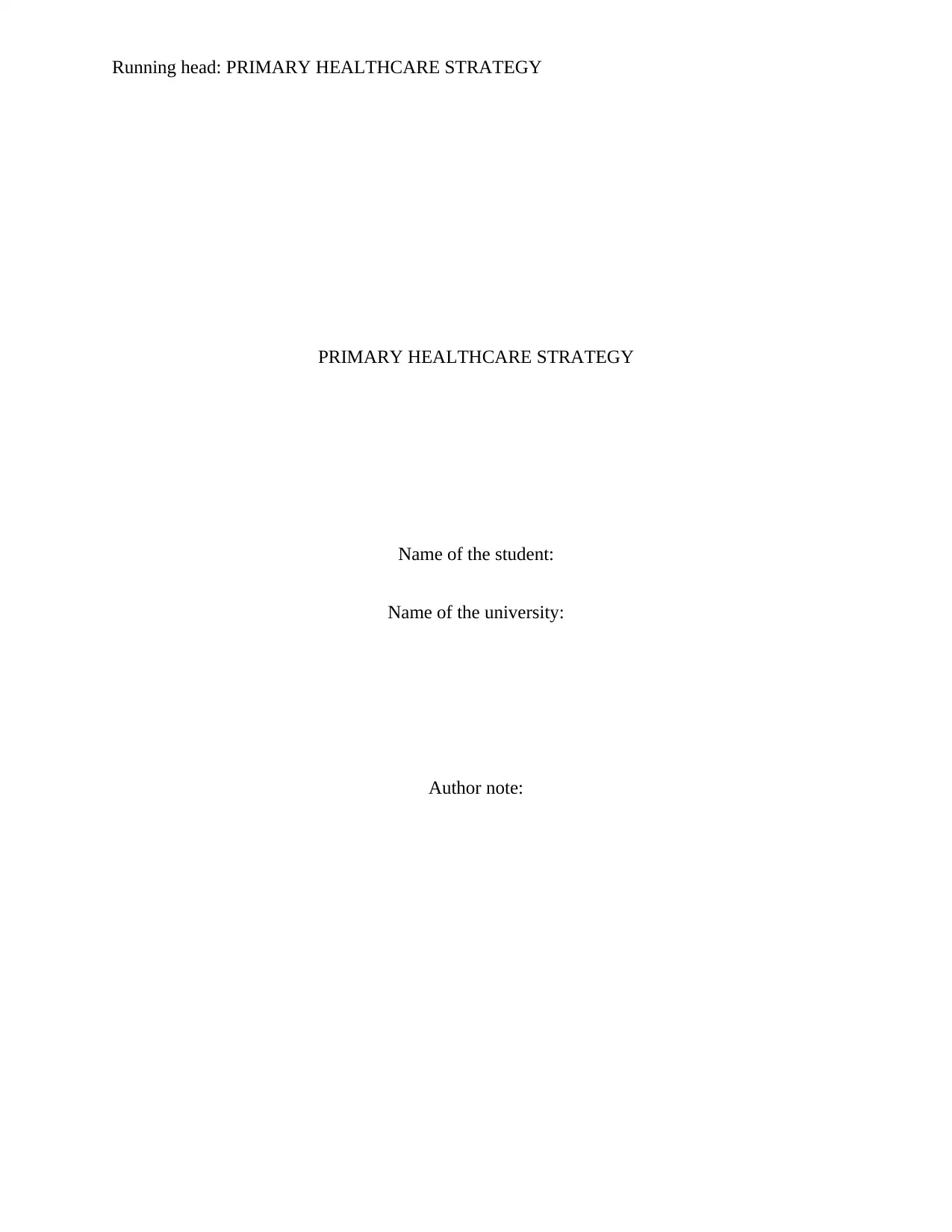
Running head: PRIMARY HEALTHCARE STRATEGY
PRIMARY HEALTHCARE STRATEGY
Name of the student:
Name of the university:
Author note:
PRIMARY HEALTHCARE STRATEGY
Name of the student:
Name of the university:
Author note:
Paraphrase This Document
Need a fresh take? Get an instant paraphrase of this document with our AI Paraphraser
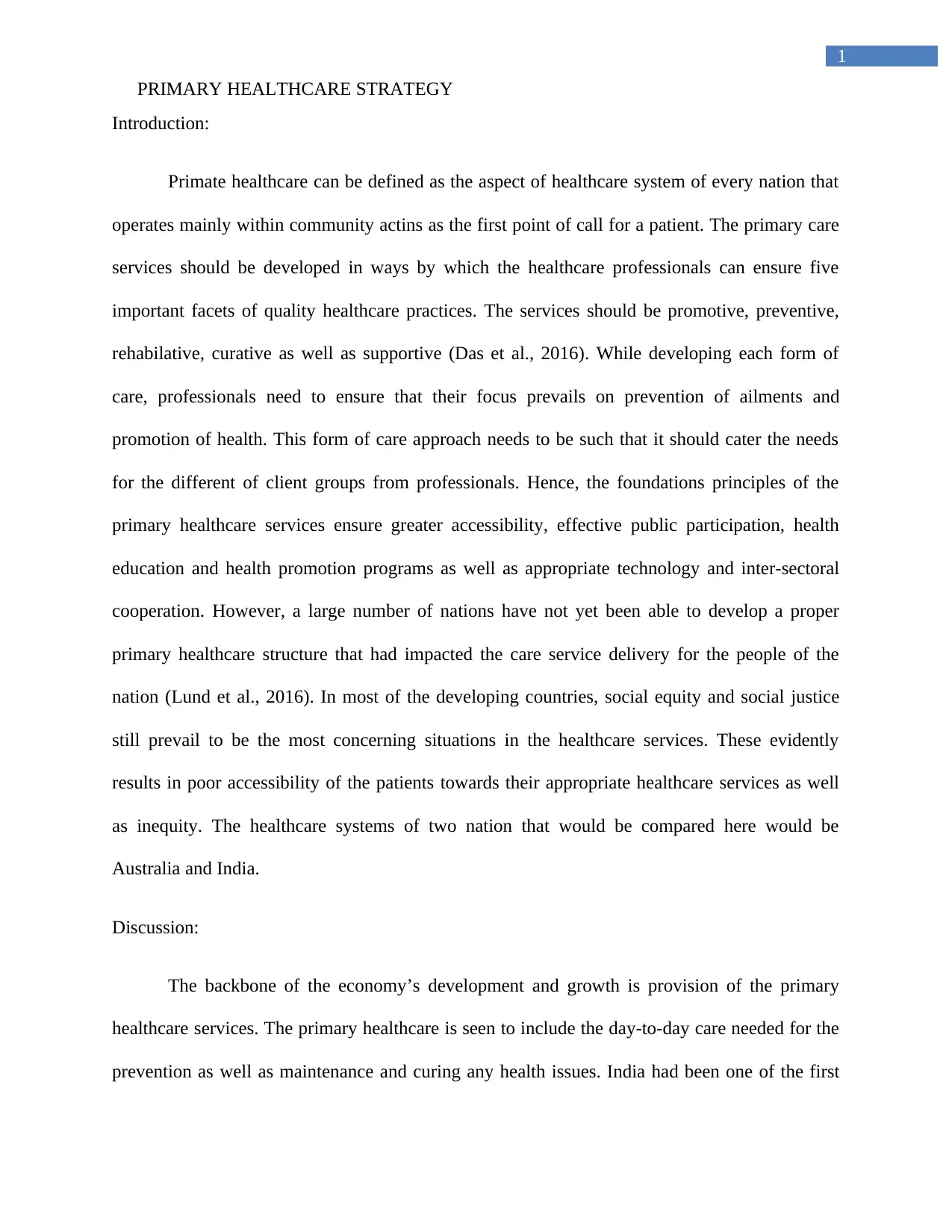
1
PRIMARY HEALTHCARE STRATEGY
Introduction:
Primate healthcare can be defined as the aspect of healthcare system of every nation that
operates mainly within community actins as the first point of call for a patient. The primary care
services should be developed in ways by which the healthcare professionals can ensure five
important facets of quality healthcare practices. The services should be promotive, preventive,
rehabilative, curative as well as supportive (Das et al., 2016). While developing each form of
care, professionals need to ensure that their focus prevails on prevention of ailments and
promotion of health. This form of care approach needs to be such that it should cater the needs
for the different of client groups from professionals. Hence, the foundations principles of the
primary healthcare services ensure greater accessibility, effective public participation, health
education and health promotion programs as well as appropriate technology and inter-sectoral
cooperation. However, a large number of nations have not yet been able to develop a proper
primary healthcare structure that had impacted the care service delivery for the people of the
nation (Lund et al., 2016). In most of the developing countries, social equity and social justice
still prevail to be the most concerning situations in the healthcare services. These evidently
results in poor accessibility of the patients towards their appropriate healthcare services as well
as inequity. The healthcare systems of two nation that would be compared here would be
Australia and India.
Discussion:
The backbone of the economy’s development and growth is provision of the primary
healthcare services. The primary healthcare is seen to include the day-to-day care needed for the
prevention as well as maintenance and curing any health issues. India had been one of the first
PRIMARY HEALTHCARE STRATEGY
Introduction:
Primate healthcare can be defined as the aspect of healthcare system of every nation that
operates mainly within community actins as the first point of call for a patient. The primary care
services should be developed in ways by which the healthcare professionals can ensure five
important facets of quality healthcare practices. The services should be promotive, preventive,
rehabilative, curative as well as supportive (Das et al., 2016). While developing each form of
care, professionals need to ensure that their focus prevails on prevention of ailments and
promotion of health. This form of care approach needs to be such that it should cater the needs
for the different of client groups from professionals. Hence, the foundations principles of the
primary healthcare services ensure greater accessibility, effective public participation, health
education and health promotion programs as well as appropriate technology and inter-sectoral
cooperation. However, a large number of nations have not yet been able to develop a proper
primary healthcare structure that had impacted the care service delivery for the people of the
nation (Lund et al., 2016). In most of the developing countries, social equity and social justice
still prevail to be the most concerning situations in the healthcare services. These evidently
results in poor accessibility of the patients towards their appropriate healthcare services as well
as inequity. The healthcare systems of two nation that would be compared here would be
Australia and India.
Discussion:
The backbone of the economy’s development and growth is provision of the primary
healthcare services. The primary healthcare is seen to include the day-to-day care needed for the
prevention as well as maintenance and curing any health issues. India had been one of the first
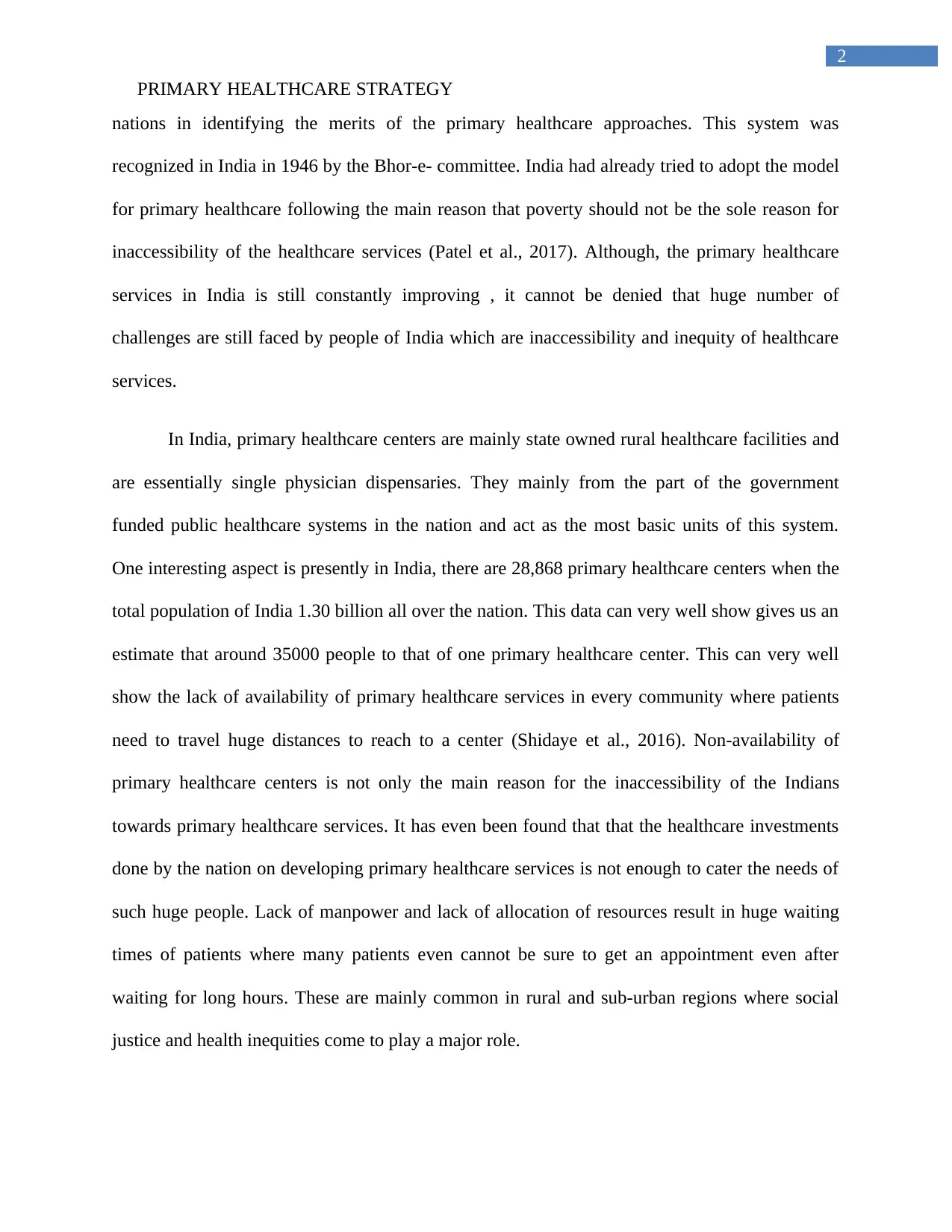
2
PRIMARY HEALTHCARE STRATEGY
nations in identifying the merits of the primary healthcare approaches. This system was
recognized in India in 1946 by the Bhor-e- committee. India had already tried to adopt the model
for primary healthcare following the main reason that poverty should not be the sole reason for
inaccessibility of the healthcare services (Patel et al., 2017). Although, the primary healthcare
services in India is still constantly improving , it cannot be denied that huge number of
challenges are still faced by people of India which are inaccessibility and inequity of healthcare
services.
In India, primary healthcare centers are mainly state owned rural healthcare facilities and
are essentially single physician dispensaries. They mainly from the part of the government
funded public healthcare systems in the nation and act as the most basic units of this system.
One interesting aspect is presently in India, there are 28,868 primary healthcare centers when the
total population of India 1.30 billion all over the nation. This data can very well show gives us an
estimate that around 35000 people to that of one primary healthcare center. This can very well
show the lack of availability of primary healthcare services in every community where patients
need to travel huge distances to reach to a center (Shidaye et al., 2016). Non-availability of
primary healthcare centers is not only the main reason for the inaccessibility of the Indians
towards primary healthcare services. It has even been found that that the healthcare investments
done by the nation on developing primary healthcare services is not enough to cater the needs of
such huge people. Lack of manpower and lack of allocation of resources result in huge waiting
times of patients where many patients even cannot be sure to get an appointment even after
waiting for long hours. These are mainly common in rural and sub-urban regions where social
justice and health inequities come to play a major role.
PRIMARY HEALTHCARE STRATEGY
nations in identifying the merits of the primary healthcare approaches. This system was
recognized in India in 1946 by the Bhor-e- committee. India had already tried to adopt the model
for primary healthcare following the main reason that poverty should not be the sole reason for
inaccessibility of the healthcare services (Patel et al., 2017). Although, the primary healthcare
services in India is still constantly improving , it cannot be denied that huge number of
challenges are still faced by people of India which are inaccessibility and inequity of healthcare
services.
In India, primary healthcare centers are mainly state owned rural healthcare facilities and
are essentially single physician dispensaries. They mainly from the part of the government
funded public healthcare systems in the nation and act as the most basic units of this system.
One interesting aspect is presently in India, there are 28,868 primary healthcare centers when the
total population of India 1.30 billion all over the nation. This data can very well show gives us an
estimate that around 35000 people to that of one primary healthcare center. This can very well
show the lack of availability of primary healthcare services in every community where patients
need to travel huge distances to reach to a center (Shidaye et al., 2016). Non-availability of
primary healthcare centers is not only the main reason for the inaccessibility of the Indians
towards primary healthcare services. It has even been found that that the healthcare investments
done by the nation on developing primary healthcare services is not enough to cater the needs of
such huge people. Lack of manpower and lack of allocation of resources result in huge waiting
times of patients where many patients even cannot be sure to get an appointment even after
waiting for long hours. These are mainly common in rural and sub-urban regions where social
justice and health inequities come to play a major role.
⊘ This is a preview!⊘
Do you want full access?
Subscribe today to unlock all pages.

Trusted by 1+ million students worldwide
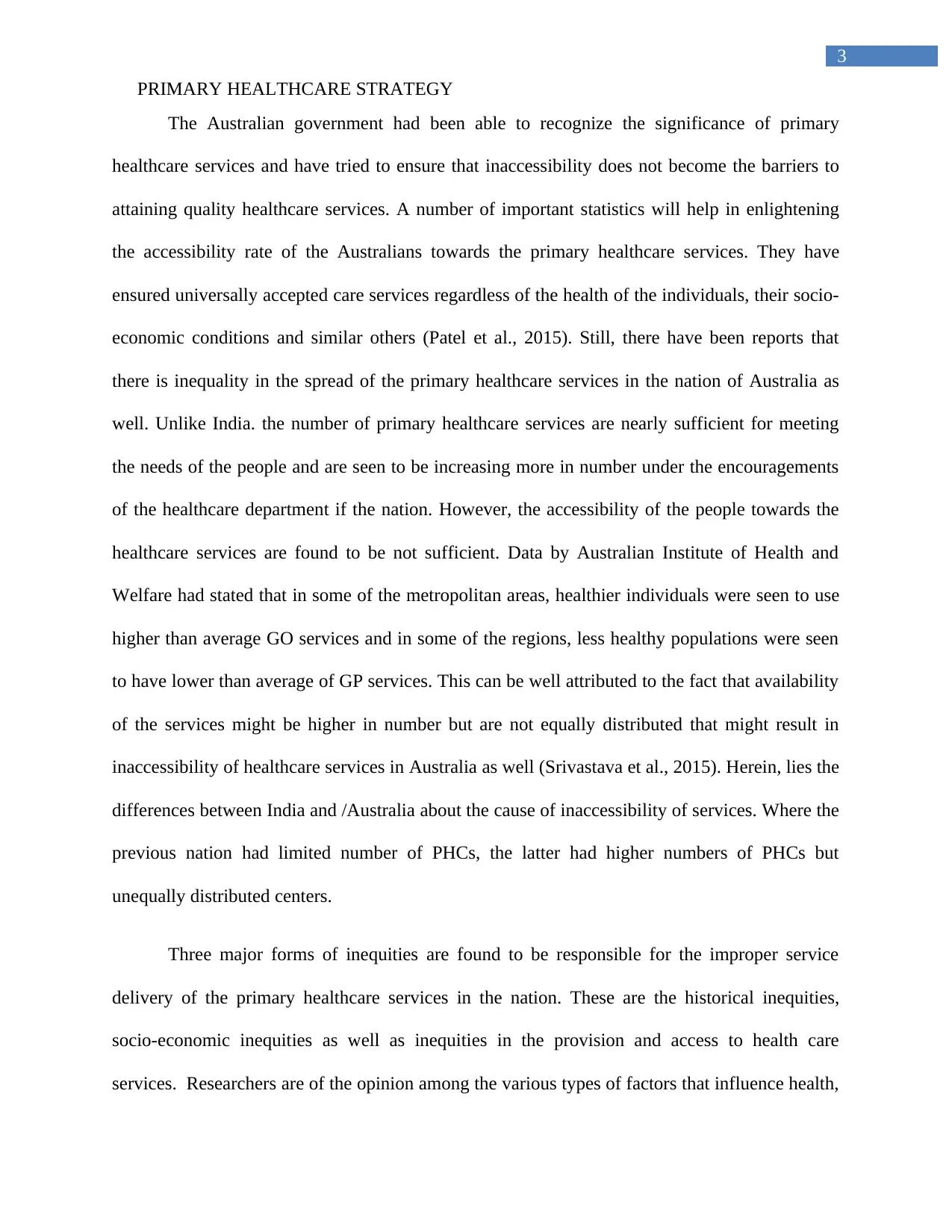
3
PRIMARY HEALTHCARE STRATEGY
The Australian government had been able to recognize the significance of primary
healthcare services and have tried to ensure that inaccessibility does not become the barriers to
attaining quality healthcare services. A number of important statistics will help in enlightening
the accessibility rate of the Australians towards the primary healthcare services. They have
ensured universally accepted care services regardless of the health of the individuals, their socio-
economic conditions and similar others (Patel et al., 2015). Still, there have been reports that
there is inequality in the spread of the primary healthcare services in the nation of Australia as
well. Unlike India. the number of primary healthcare services are nearly sufficient for meeting
the needs of the people and are seen to be increasing more in number under the encouragements
of the healthcare department if the nation. However, the accessibility of the people towards the
healthcare services are found to be not sufficient. Data by Australian Institute of Health and
Welfare had stated that in some of the metropolitan areas, healthier individuals were seen to use
higher than average GO services and in some of the regions, less healthy populations were seen
to have lower than average of GP services. This can be well attributed to the fact that availability
of the services might be higher in number but are not equally distributed that might result in
inaccessibility of healthcare services in Australia as well (Srivastava et al., 2015). Herein, lies the
differences between India and /Australia about the cause of inaccessibility of services. Where the
previous nation had limited number of PHCs, the latter had higher numbers of PHCs but
unequally distributed centers.
Three major forms of inequities are found to be responsible for the improper service
delivery of the primary healthcare services in the nation. These are the historical inequities,
socio-economic inequities as well as inequities in the provision and access to health care
services. Researchers are of the opinion among the various types of factors that influence health,
PRIMARY HEALTHCARE STRATEGY
The Australian government had been able to recognize the significance of primary
healthcare services and have tried to ensure that inaccessibility does not become the barriers to
attaining quality healthcare services. A number of important statistics will help in enlightening
the accessibility rate of the Australians towards the primary healthcare services. They have
ensured universally accepted care services regardless of the health of the individuals, their socio-
economic conditions and similar others (Patel et al., 2015). Still, there have been reports that
there is inequality in the spread of the primary healthcare services in the nation of Australia as
well. Unlike India. the number of primary healthcare services are nearly sufficient for meeting
the needs of the people and are seen to be increasing more in number under the encouragements
of the healthcare department if the nation. However, the accessibility of the people towards the
healthcare services are found to be not sufficient. Data by Australian Institute of Health and
Welfare had stated that in some of the metropolitan areas, healthier individuals were seen to use
higher than average GO services and in some of the regions, less healthy populations were seen
to have lower than average of GP services. This can be well attributed to the fact that availability
of the services might be higher in number but are not equally distributed that might result in
inaccessibility of healthcare services in Australia as well (Srivastava et al., 2015). Herein, lies the
differences between India and /Australia about the cause of inaccessibility of services. Where the
previous nation had limited number of PHCs, the latter had higher numbers of PHCs but
unequally distributed centers.
Three major forms of inequities are found to be responsible for the improper service
delivery of the primary healthcare services in the nation. These are the historical inequities,
socio-economic inequities as well as inequities in the provision and access to health care
services. Researchers are of the opinion among the various types of factors that influence health,
Paraphrase This Document
Need a fresh take? Get an instant paraphrase of this document with our AI Paraphraser
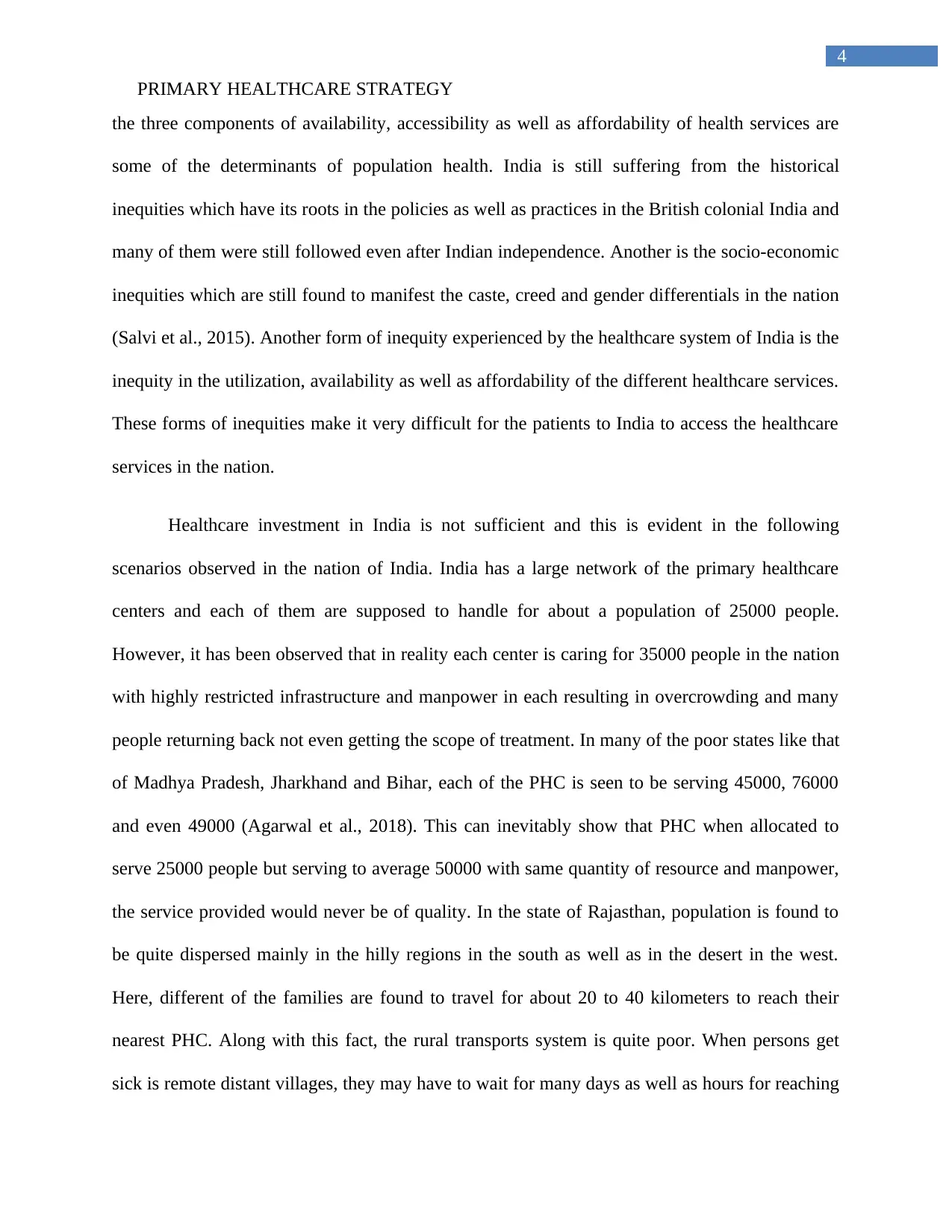
4
PRIMARY HEALTHCARE STRATEGY
the three components of availability, accessibility as well as affordability of health services are
some of the determinants of population health. India is still suffering from the historical
inequities which have its roots in the policies as well as practices in the British colonial India and
many of them were still followed even after Indian independence. Another is the socio-economic
inequities which are still found to manifest the caste, creed and gender differentials in the nation
(Salvi et al., 2015). Another form of inequity experienced by the healthcare system of India is the
inequity in the utilization, availability as well as affordability of the different healthcare services.
These forms of inequities make it very difficult for the patients to India to access the healthcare
services in the nation.
Healthcare investment in India is not sufficient and this is evident in the following
scenarios observed in the nation of India. India has a large network of the primary healthcare
centers and each of them are supposed to handle for about a population of 25000 people.
However, it has been observed that in reality each center is caring for 35000 people in the nation
with highly restricted infrastructure and manpower in each resulting in overcrowding and many
people returning back not even getting the scope of treatment. In many of the poor states like that
of Madhya Pradesh, Jharkhand and Bihar, each of the PHC is seen to be serving 45000, 76000
and even 49000 (Agarwal et al., 2018). This can inevitably show that PHC when allocated to
serve 25000 people but serving to average 50000 with same quantity of resource and manpower,
the service provided would never be of quality. In the state of Rajasthan, population is found to
be quite dispersed mainly in the hilly regions in the south as well as in the desert in the west.
Here, different of the families are found to travel for about 20 to 40 kilometers to reach their
nearest PHC. Along with this fact, the rural transports system is quite poor. When persons get
sick is remote distant villages, they may have to wait for many days as well as hours for reaching
PRIMARY HEALTHCARE STRATEGY
the three components of availability, accessibility as well as affordability of health services are
some of the determinants of population health. India is still suffering from the historical
inequities which have its roots in the policies as well as practices in the British colonial India and
many of them were still followed even after Indian independence. Another is the socio-economic
inequities which are still found to manifest the caste, creed and gender differentials in the nation
(Salvi et al., 2015). Another form of inequity experienced by the healthcare system of India is the
inequity in the utilization, availability as well as affordability of the different healthcare services.
These forms of inequities make it very difficult for the patients to India to access the healthcare
services in the nation.
Healthcare investment in India is not sufficient and this is evident in the following
scenarios observed in the nation of India. India has a large network of the primary healthcare
centers and each of them are supposed to handle for about a population of 25000 people.
However, it has been observed that in reality each center is caring for 35000 people in the nation
with highly restricted infrastructure and manpower in each resulting in overcrowding and many
people returning back not even getting the scope of treatment. In many of the poor states like that
of Madhya Pradesh, Jharkhand and Bihar, each of the PHC is seen to be serving 45000, 76000
and even 49000 (Agarwal et al., 2018). This can inevitably show that PHC when allocated to
serve 25000 people but serving to average 50000 with same quantity of resource and manpower,
the service provided would never be of quality. In the state of Rajasthan, population is found to
be quite dispersed mainly in the hilly regions in the south as well as in the desert in the west.
Here, different of the families are found to travel for about 20 to 40 kilometers to reach their
nearest PHC. Along with this fact, the rural transports system is quite poor. When persons get
sick is remote distant villages, they may have to wait for many days as well as hours for reaching
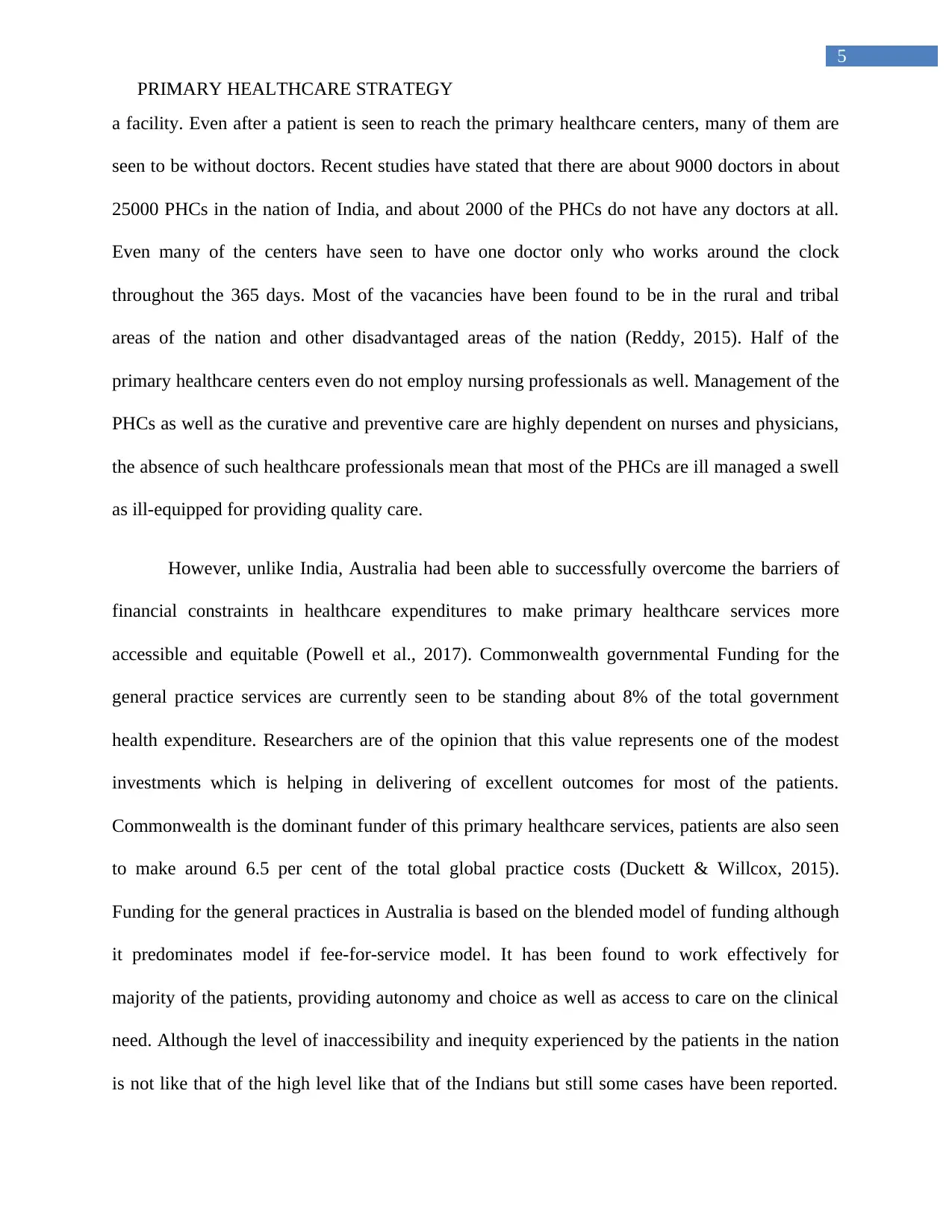
5
PRIMARY HEALTHCARE STRATEGY
a facility. Even after a patient is seen to reach the primary healthcare centers, many of them are
seen to be without doctors. Recent studies have stated that there are about 9000 doctors in about
25000 PHCs in the nation of India, and about 2000 of the PHCs do not have any doctors at all.
Even many of the centers have seen to have one doctor only who works around the clock
throughout the 365 days. Most of the vacancies have been found to be in the rural and tribal
areas of the nation and other disadvantaged areas of the nation (Reddy, 2015). Half of the
primary healthcare centers even do not employ nursing professionals as well. Management of the
PHCs as well as the curative and preventive care are highly dependent on nurses and physicians,
the absence of such healthcare professionals mean that most of the PHCs are ill managed a swell
as ill-equipped for providing quality care.
However, unlike India, Australia had been able to successfully overcome the barriers of
financial constraints in healthcare expenditures to make primary healthcare services more
accessible and equitable (Powell et al., 2017). Commonwealth governmental Funding for the
general practice services are currently seen to be standing about 8% of the total government
health expenditure. Researchers are of the opinion that this value represents one of the modest
investments which is helping in delivering of excellent outcomes for most of the patients.
Commonwealth is the dominant funder of this primary healthcare services, patients are also seen
to make around 6.5 per cent of the total global practice costs (Duckett & Willcox, 2015).
Funding for the general practices in Australia is based on the blended model of funding although
it predominates model if fee-for-service model. It has been found to work effectively for
majority of the patients, providing autonomy and choice as well as access to care on the clinical
need. Although the level of inaccessibility and inequity experienced by the patients in the nation
is not like that of the high level like that of the Indians but still some cases have been reported.
PRIMARY HEALTHCARE STRATEGY
a facility. Even after a patient is seen to reach the primary healthcare centers, many of them are
seen to be without doctors. Recent studies have stated that there are about 9000 doctors in about
25000 PHCs in the nation of India, and about 2000 of the PHCs do not have any doctors at all.
Even many of the centers have seen to have one doctor only who works around the clock
throughout the 365 days. Most of the vacancies have been found to be in the rural and tribal
areas of the nation and other disadvantaged areas of the nation (Reddy, 2015). Half of the
primary healthcare centers even do not employ nursing professionals as well. Management of the
PHCs as well as the curative and preventive care are highly dependent on nurses and physicians,
the absence of such healthcare professionals mean that most of the PHCs are ill managed a swell
as ill-equipped for providing quality care.
However, unlike India, Australia had been able to successfully overcome the barriers of
financial constraints in healthcare expenditures to make primary healthcare services more
accessible and equitable (Powell et al., 2017). Commonwealth governmental Funding for the
general practice services are currently seen to be standing about 8% of the total government
health expenditure. Researchers are of the opinion that this value represents one of the modest
investments which is helping in delivering of excellent outcomes for most of the patients.
Commonwealth is the dominant funder of this primary healthcare services, patients are also seen
to make around 6.5 per cent of the total global practice costs (Duckett & Willcox, 2015).
Funding for the general practices in Australia is based on the blended model of funding although
it predominates model if fee-for-service model. It has been found to work effectively for
majority of the patients, providing autonomy and choice as well as access to care on the clinical
need. Although the level of inaccessibility and inequity experienced by the patients in the nation
is not like that of the high level like that of the Indians but still some cases have been reported.
⊘ This is a preview!⊘
Do you want full access?
Subscribe today to unlock all pages.

Trusted by 1+ million students worldwide
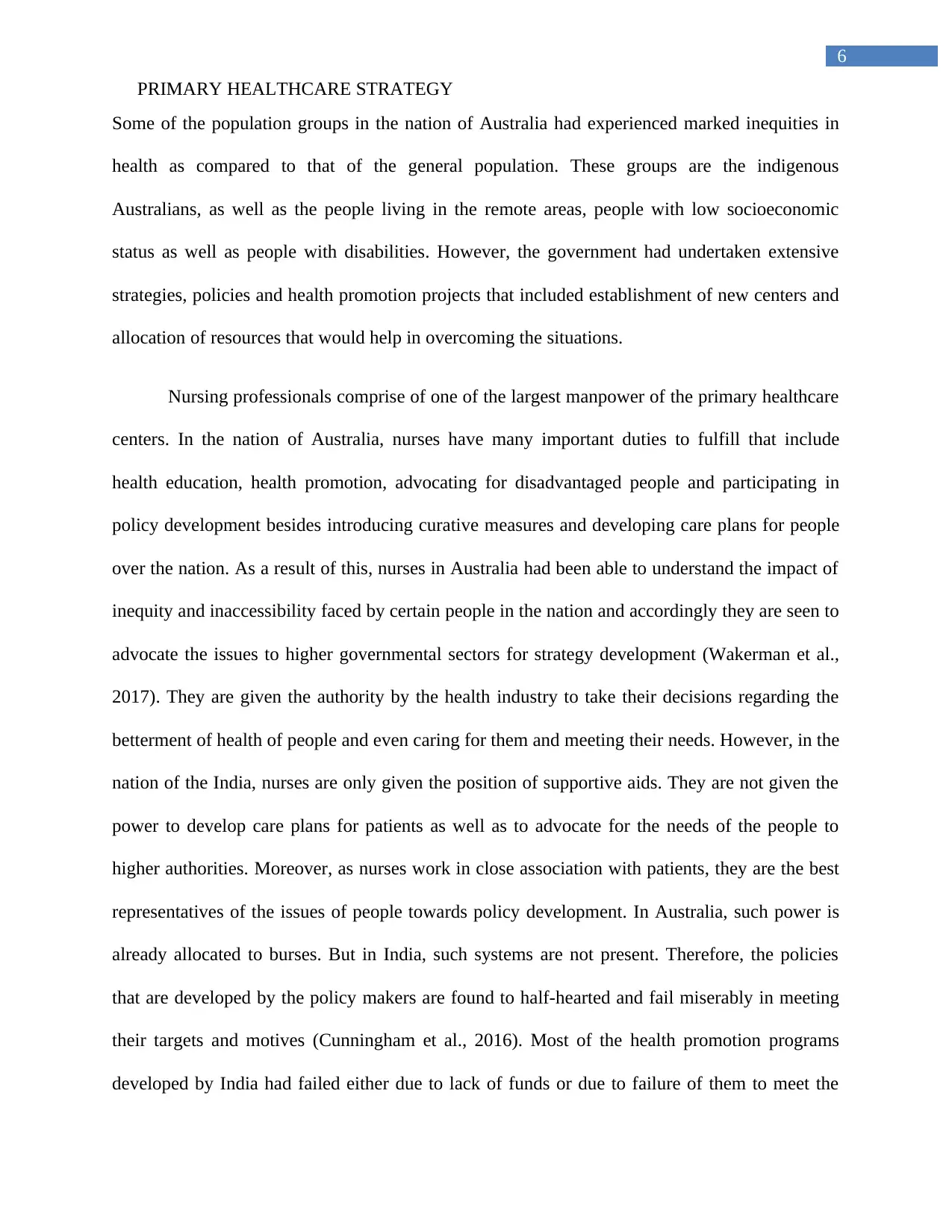
6
PRIMARY HEALTHCARE STRATEGY
Some of the population groups in the nation of Australia had experienced marked inequities in
health as compared to that of the general population. These groups are the indigenous
Australians, as well as the people living in the remote areas, people with low socioeconomic
status as well as people with disabilities. However, the government had undertaken extensive
strategies, policies and health promotion projects that included establishment of new centers and
allocation of resources that would help in overcoming the situations.
Nursing professionals comprise of one of the largest manpower of the primary healthcare
centers. In the nation of Australia, nurses have many important duties to fulfill that include
health education, health promotion, advocating for disadvantaged people and participating in
policy development besides introducing curative measures and developing care plans for people
over the nation. As a result of this, nurses in Australia had been able to understand the impact of
inequity and inaccessibility faced by certain people in the nation and accordingly they are seen to
advocate the issues to higher governmental sectors for strategy development (Wakerman et al.,
2017). They are given the authority by the health industry to take their decisions regarding the
betterment of health of people and even caring for them and meeting their needs. However, in the
nation of the India, nurses are only given the position of supportive aids. They are not given the
power to develop care plans for patients as well as to advocate for the needs of the people to
higher authorities. Moreover, as nurses work in close association with patients, they are the best
representatives of the issues of people towards policy development. In Australia, such power is
already allocated to burses. But in India, such systems are not present. Therefore, the policies
that are developed by the policy makers are found to half-hearted and fail miserably in meeting
their targets and motives (Cunningham et al., 2016). Most of the health promotion programs
developed by India had failed either due to lack of funds or due to failure of them to meet the
PRIMARY HEALTHCARE STRATEGY
Some of the population groups in the nation of Australia had experienced marked inequities in
health as compared to that of the general population. These groups are the indigenous
Australians, as well as the people living in the remote areas, people with low socioeconomic
status as well as people with disabilities. However, the government had undertaken extensive
strategies, policies and health promotion projects that included establishment of new centers and
allocation of resources that would help in overcoming the situations.
Nursing professionals comprise of one of the largest manpower of the primary healthcare
centers. In the nation of Australia, nurses have many important duties to fulfill that include
health education, health promotion, advocating for disadvantaged people and participating in
policy development besides introducing curative measures and developing care plans for people
over the nation. As a result of this, nurses in Australia had been able to understand the impact of
inequity and inaccessibility faced by certain people in the nation and accordingly they are seen to
advocate the issues to higher governmental sectors for strategy development (Wakerman et al.,
2017). They are given the authority by the health industry to take their decisions regarding the
betterment of health of people and even caring for them and meeting their needs. However, in the
nation of the India, nurses are only given the position of supportive aids. They are not given the
power to develop care plans for patients as well as to advocate for the needs of the people to
higher authorities. Moreover, as nurses work in close association with patients, they are the best
representatives of the issues of people towards policy development. In Australia, such power is
already allocated to burses. But in India, such systems are not present. Therefore, the policies
that are developed by the policy makers are found to half-hearted and fail miserably in meeting
their targets and motives (Cunningham et al., 2016). Most of the health promotion programs
developed by India had failed either due to lack of funds or due to failure of them to meet the
Paraphrase This Document
Need a fresh take? Get an instant paraphrase of this document with our AI Paraphraser
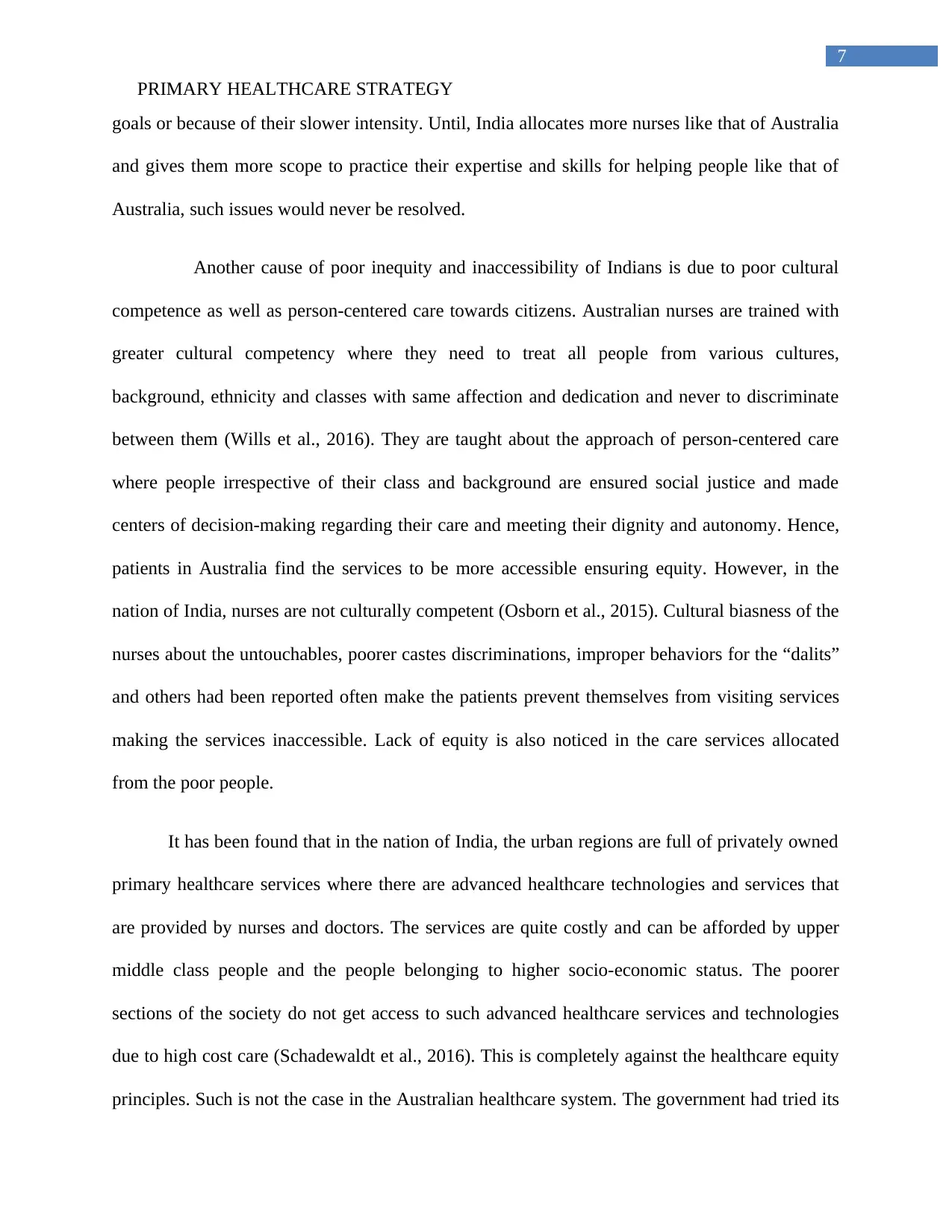
7
PRIMARY HEALTHCARE STRATEGY
goals or because of their slower intensity. Until, India allocates more nurses like that of Australia
and gives them more scope to practice their expertise and skills for helping people like that of
Australia, such issues would never be resolved.
Another cause of poor inequity and inaccessibility of Indians is due to poor cultural
competence as well as person-centered care towards citizens. Australian nurses are trained with
greater cultural competency where they need to treat all people from various cultures,
background, ethnicity and classes with same affection and dedication and never to discriminate
between them (Wills et al., 2016). They are taught about the approach of person-centered care
where people irrespective of their class and background are ensured social justice and made
centers of decision-making regarding their care and meeting their dignity and autonomy. Hence,
patients in Australia find the services to be more accessible ensuring equity. However, in the
nation of India, nurses are not culturally competent (Osborn et al., 2015). Cultural biasness of the
nurses about the untouchables, poorer castes discriminations, improper behaviors for the “dalits”
and others had been reported often make the patients prevent themselves from visiting services
making the services inaccessible. Lack of equity is also noticed in the care services allocated
from the poor people.
It has been found that in the nation of India, the urban regions are full of privately owned
primary healthcare services where there are advanced healthcare technologies and services that
are provided by nurses and doctors. The services are quite costly and can be afforded by upper
middle class people and the people belonging to higher socio-economic status. The poorer
sections of the society do not get access to such advanced healthcare services and technologies
due to high cost care (Schadewaldt et al., 2016). This is completely against the healthcare equity
principles. Such is not the case in the Australian healthcare system. The government had tried its
PRIMARY HEALTHCARE STRATEGY
goals or because of their slower intensity. Until, India allocates more nurses like that of Australia
and gives them more scope to practice their expertise and skills for helping people like that of
Australia, such issues would never be resolved.
Another cause of poor inequity and inaccessibility of Indians is due to poor cultural
competence as well as person-centered care towards citizens. Australian nurses are trained with
greater cultural competency where they need to treat all people from various cultures,
background, ethnicity and classes with same affection and dedication and never to discriminate
between them (Wills et al., 2016). They are taught about the approach of person-centered care
where people irrespective of their class and background are ensured social justice and made
centers of decision-making regarding their care and meeting their dignity and autonomy. Hence,
patients in Australia find the services to be more accessible ensuring equity. However, in the
nation of India, nurses are not culturally competent (Osborn et al., 2015). Cultural biasness of the
nurses about the untouchables, poorer castes discriminations, improper behaviors for the “dalits”
and others had been reported often make the patients prevent themselves from visiting services
making the services inaccessible. Lack of equity is also noticed in the care services allocated
from the poor people.
It has been found that in the nation of India, the urban regions are full of privately owned
primary healthcare services where there are advanced healthcare technologies and services that
are provided by nurses and doctors. The services are quite costly and can be afforded by upper
middle class people and the people belonging to higher socio-economic status. The poorer
sections of the society do not get access to such advanced healthcare services and technologies
due to high cost care (Schadewaldt et al., 2016). This is completely against the healthcare equity
principles. Such is not the case in the Australian healthcare system. The government had tried its
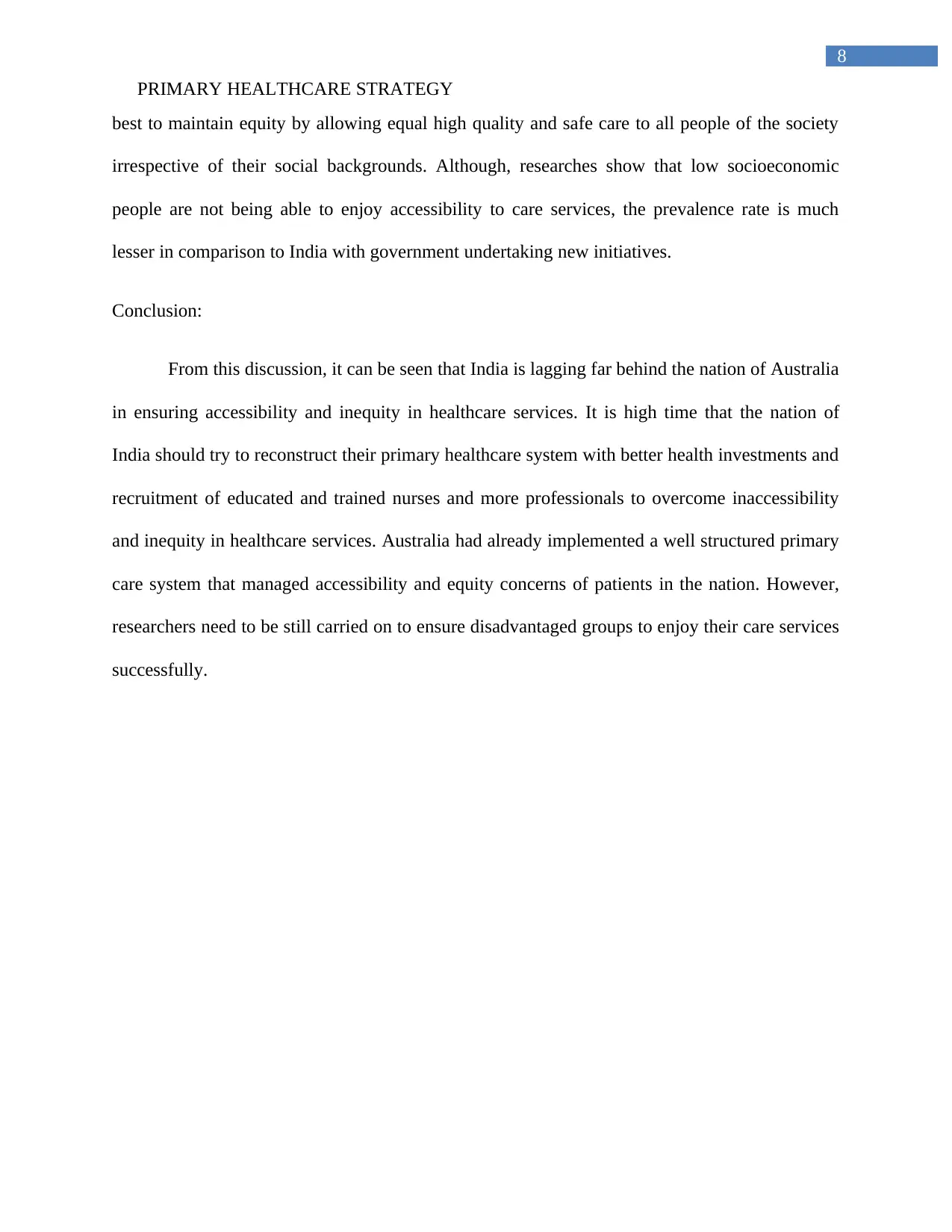
8
PRIMARY HEALTHCARE STRATEGY
best to maintain equity by allowing equal high quality and safe care to all people of the society
irrespective of their social backgrounds. Although, researches show that low socioeconomic
people are not being able to enjoy accessibility to care services, the prevalence rate is much
lesser in comparison to India with government undertaking new initiatives.
Conclusion:
From this discussion, it can be seen that India is lagging far behind the nation of Australia
in ensuring accessibility and inequity in healthcare services. It is high time that the nation of
India should try to reconstruct their primary healthcare system with better health investments and
recruitment of educated and trained nurses and more professionals to overcome inaccessibility
and inequity in healthcare services. Australia had already implemented a well structured primary
care system that managed accessibility and equity concerns of patients in the nation. However,
researchers need to be still carried on to ensure disadvantaged groups to enjoy their care services
successfully.
PRIMARY HEALTHCARE STRATEGY
best to maintain equity by allowing equal high quality and safe care to all people of the society
irrespective of their social backgrounds. Although, researches show that low socioeconomic
people are not being able to enjoy accessibility to care services, the prevalence rate is much
lesser in comparison to India with government undertaking new initiatives.
Conclusion:
From this discussion, it can be seen that India is lagging far behind the nation of Australia
in ensuring accessibility and inequity in healthcare services. It is high time that the nation of
India should try to reconstruct their primary healthcare system with better health investments and
recruitment of educated and trained nurses and more professionals to overcome inaccessibility
and inequity in healthcare services. Australia had already implemented a well structured primary
care system that managed accessibility and equity concerns of patients in the nation. However,
researchers need to be still carried on to ensure disadvantaged groups to enjoy their care services
successfully.
⊘ This is a preview!⊘
Do you want full access?
Subscribe today to unlock all pages.

Trusted by 1+ million students worldwide
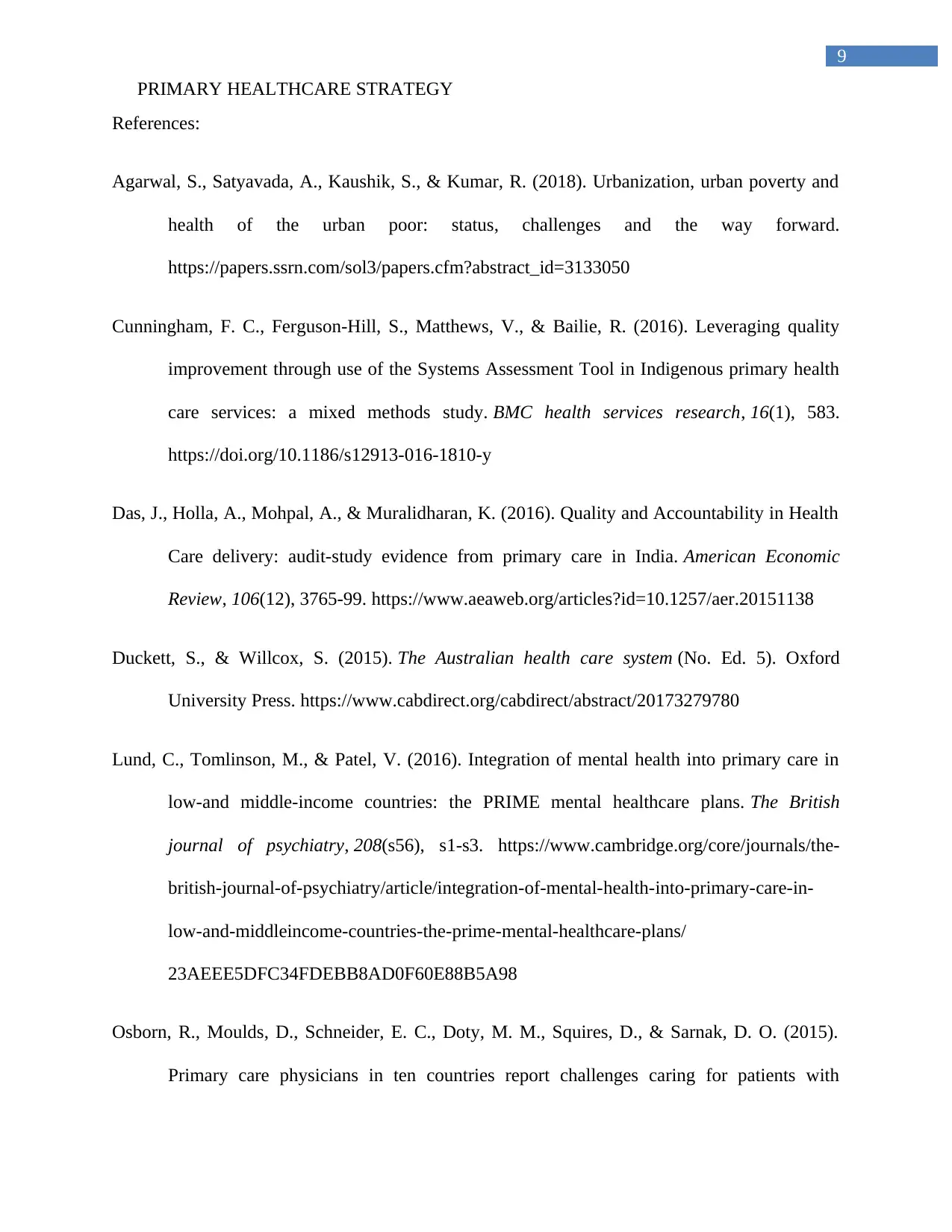
9
PRIMARY HEALTHCARE STRATEGY
References:
Agarwal, S., Satyavada, A., Kaushik, S., & Kumar, R. (2018). Urbanization, urban poverty and
health of the urban poor: status, challenges and the way forward.
https://papers.ssrn.com/sol3/papers.cfm?abstract_id=3133050
Cunningham, F. C., Ferguson-Hill, S., Matthews, V., & Bailie, R. (2016). Leveraging quality
improvement through use of the Systems Assessment Tool in Indigenous primary health
care services: a mixed methods study. BMC health services research, 16(1), 583.
https://doi.org/10.1186/s12913-016-1810-y
Das, J., Holla, A., Mohpal, A., & Muralidharan, K. (2016). Quality and Accountability in Health
Care delivery: audit-study evidence from primary care in India. American Economic
Review, 106(12), 3765-99. https://www.aeaweb.org/articles?id=10.1257/aer.20151138
Duckett, S., & Willcox, S. (2015). The Australian health care system (No. Ed. 5). Oxford
University Press. https://www.cabdirect.org/cabdirect/abstract/20173279780
Lund, C., Tomlinson, M., & Patel, V. (2016). Integration of mental health into primary care in
low-and middle-income countries: the PRIME mental healthcare plans. The British
journal of psychiatry, 208(s56), s1-s3. https://www.cambridge.org/core/journals/the-
british-journal-of-psychiatry/article/integration-of-mental-health-into-primary-care-in-
low-and-middleincome-countries-the-prime-mental-healthcare-plans/
23AEEE5DFC34FDEBB8AD0F60E88B5A98
Osborn, R., Moulds, D., Schneider, E. C., Doty, M. M., Squires, D., & Sarnak, D. O. (2015).
Primary care physicians in ten countries report challenges caring for patients with
PRIMARY HEALTHCARE STRATEGY
References:
Agarwal, S., Satyavada, A., Kaushik, S., & Kumar, R. (2018). Urbanization, urban poverty and
health of the urban poor: status, challenges and the way forward.
https://papers.ssrn.com/sol3/papers.cfm?abstract_id=3133050
Cunningham, F. C., Ferguson-Hill, S., Matthews, V., & Bailie, R. (2016). Leveraging quality
improvement through use of the Systems Assessment Tool in Indigenous primary health
care services: a mixed methods study. BMC health services research, 16(1), 583.
https://doi.org/10.1186/s12913-016-1810-y
Das, J., Holla, A., Mohpal, A., & Muralidharan, K. (2016). Quality and Accountability in Health
Care delivery: audit-study evidence from primary care in India. American Economic
Review, 106(12), 3765-99. https://www.aeaweb.org/articles?id=10.1257/aer.20151138
Duckett, S., & Willcox, S. (2015). The Australian health care system (No. Ed. 5). Oxford
University Press. https://www.cabdirect.org/cabdirect/abstract/20173279780
Lund, C., Tomlinson, M., & Patel, V. (2016). Integration of mental health into primary care in
low-and middle-income countries: the PRIME mental healthcare plans. The British
journal of psychiatry, 208(s56), s1-s3. https://www.cambridge.org/core/journals/the-
british-journal-of-psychiatry/article/integration-of-mental-health-into-primary-care-in-
low-and-middleincome-countries-the-prime-mental-healthcare-plans/
23AEEE5DFC34FDEBB8AD0F60E88B5A98
Osborn, R., Moulds, D., Schneider, E. C., Doty, M. M., Squires, D., & Sarnak, D. O. (2015).
Primary care physicians in ten countries report challenges caring for patients with
Paraphrase This Document
Need a fresh take? Get an instant paraphrase of this document with our AI Paraphraser
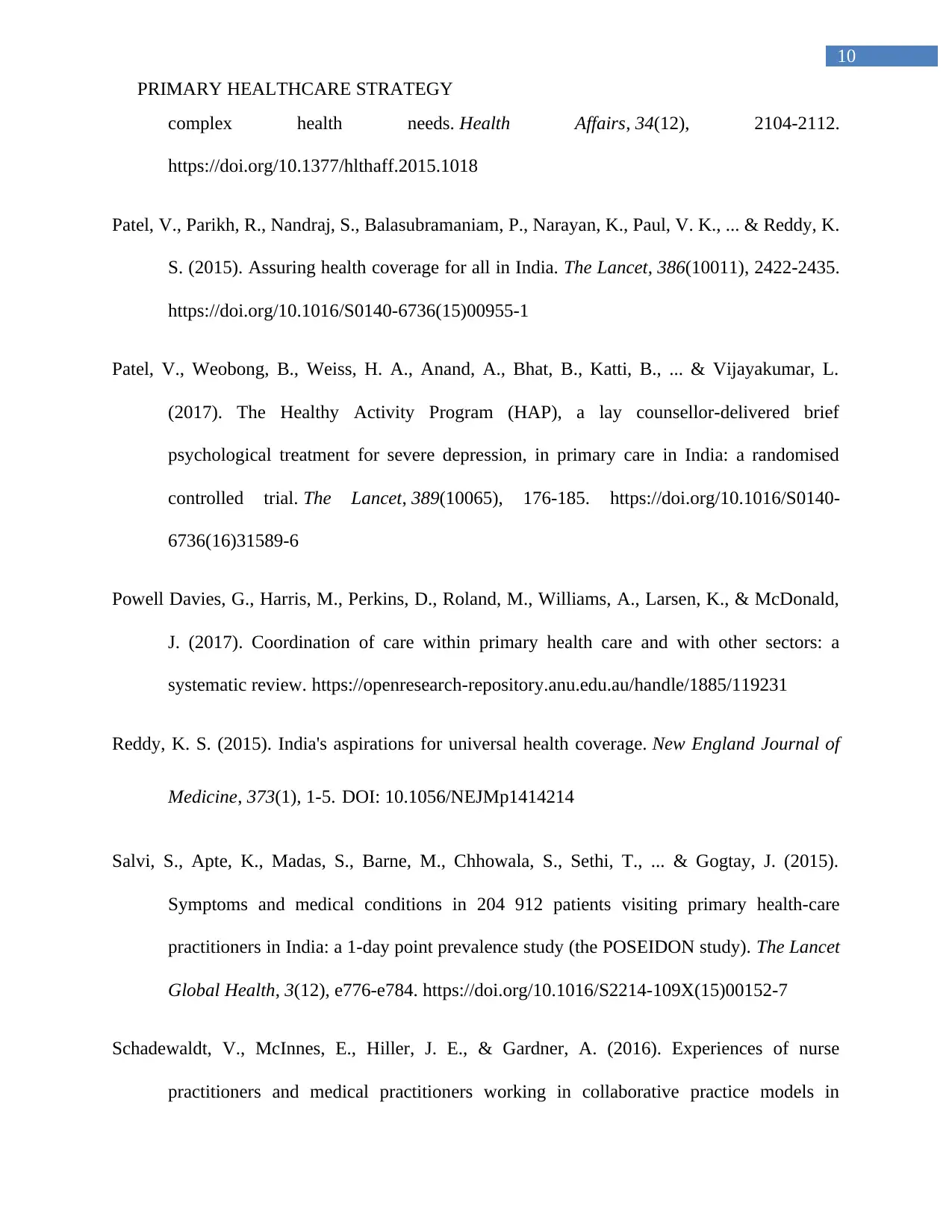
10
PRIMARY HEALTHCARE STRATEGY
complex health needs. Health Affairs, 34(12), 2104-2112.
https://doi.org/10.1377/hlthaff.2015.1018
Patel, V., Parikh, R., Nandraj, S., Balasubramaniam, P., Narayan, K., Paul, V. K., ... & Reddy, K.
S. (2015). Assuring health coverage for all in India. The Lancet, 386(10011), 2422-2435.
https://doi.org/10.1016/S0140-6736(15)00955-1
Patel, V., Weobong, B., Weiss, H. A., Anand, A., Bhat, B., Katti, B., ... & Vijayakumar, L.
(2017). The Healthy Activity Program (HAP), a lay counsellor-delivered brief
psychological treatment for severe depression, in primary care in India: a randomised
controlled trial. The Lancet, 389(10065), 176-185. https://doi.org/10.1016/S0140-
6736(16)31589-6
Powell Davies, G., Harris, M., Perkins, D., Roland, M., Williams, A., Larsen, K., & McDonald,
J. (2017). Coordination of care within primary health care and with other sectors: a
systematic review. https://openresearch-repository.anu.edu.au/handle/1885/119231
Reddy, K. S. (2015). India's aspirations for universal health coverage. New England Journal of
Medicine, 373(1), 1-5. DOI: 10.1056/NEJMp1414214
Salvi, S., Apte, K., Madas, S., Barne, M., Chhowala, S., Sethi, T., ... & Gogtay, J. (2015).
Symptoms and medical conditions in 204 912 patients visiting primary health-care
practitioners in India: a 1-day point prevalence study (the POSEIDON study). The Lancet
Global Health, 3(12), e776-e784. https://doi.org/10.1016/S2214-109X(15)00152-7
Schadewaldt, V., McInnes, E., Hiller, J. E., & Gardner, A. (2016). Experiences of nurse
practitioners and medical practitioners working in collaborative practice models in
PRIMARY HEALTHCARE STRATEGY
complex health needs. Health Affairs, 34(12), 2104-2112.
https://doi.org/10.1377/hlthaff.2015.1018
Patel, V., Parikh, R., Nandraj, S., Balasubramaniam, P., Narayan, K., Paul, V. K., ... & Reddy, K.
S. (2015). Assuring health coverage for all in India. The Lancet, 386(10011), 2422-2435.
https://doi.org/10.1016/S0140-6736(15)00955-1
Patel, V., Weobong, B., Weiss, H. A., Anand, A., Bhat, B., Katti, B., ... & Vijayakumar, L.
(2017). The Healthy Activity Program (HAP), a lay counsellor-delivered brief
psychological treatment for severe depression, in primary care in India: a randomised
controlled trial. The Lancet, 389(10065), 176-185. https://doi.org/10.1016/S0140-
6736(16)31589-6
Powell Davies, G., Harris, M., Perkins, D., Roland, M., Williams, A., Larsen, K., & McDonald,
J. (2017). Coordination of care within primary health care and with other sectors: a
systematic review. https://openresearch-repository.anu.edu.au/handle/1885/119231
Reddy, K. S. (2015). India's aspirations for universal health coverage. New England Journal of
Medicine, 373(1), 1-5. DOI: 10.1056/NEJMp1414214
Salvi, S., Apte, K., Madas, S., Barne, M., Chhowala, S., Sethi, T., ... & Gogtay, J. (2015).
Symptoms and medical conditions in 204 912 patients visiting primary health-care
practitioners in India: a 1-day point prevalence study (the POSEIDON study). The Lancet
Global Health, 3(12), e776-e784. https://doi.org/10.1016/S2214-109X(15)00152-7
Schadewaldt, V., McInnes, E., Hiller, J. E., & Gardner, A. (2016). Experiences of nurse
practitioners and medical practitioners working in collaborative practice models in
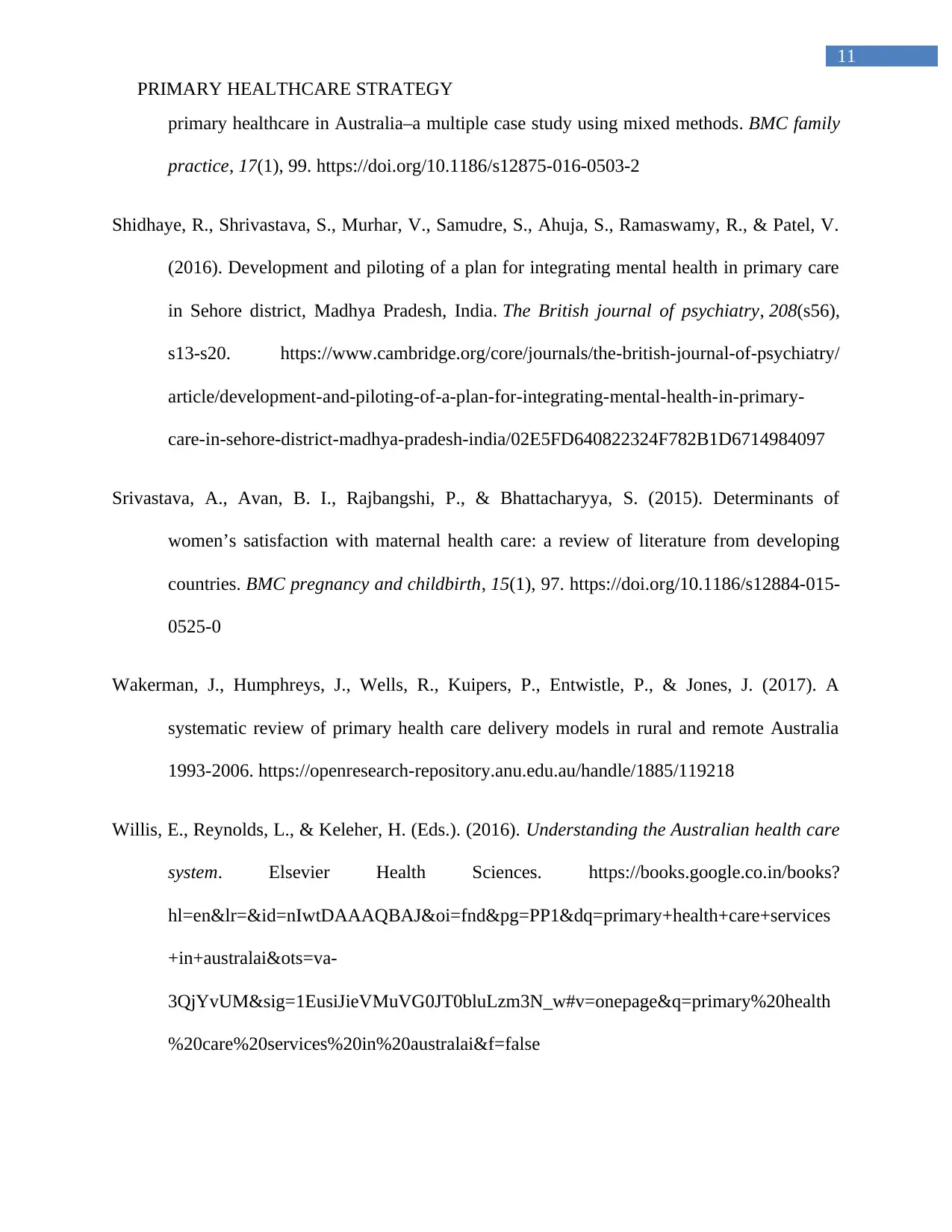
11
PRIMARY HEALTHCARE STRATEGY
primary healthcare in Australia–a multiple case study using mixed methods. BMC family
practice, 17(1), 99. https://doi.org/10.1186/s12875-016-0503-2
Shidhaye, R., Shrivastava, S., Murhar, V., Samudre, S., Ahuja, S., Ramaswamy, R., & Patel, V.
(2016). Development and piloting of a plan for integrating mental health in primary care
in Sehore district, Madhya Pradesh, India. The British journal of psychiatry, 208(s56),
s13-s20. https://www.cambridge.org/core/journals/the-british-journal-of-psychiatry/
article/development-and-piloting-of-a-plan-for-integrating-mental-health-in-primary-
care-in-sehore-district-madhya-pradesh-india/02E5FD640822324F782B1D6714984097
Srivastava, A., Avan, B. I., Rajbangshi, P., & Bhattacharyya, S. (2015). Determinants of
women’s satisfaction with maternal health care: a review of literature from developing
countries. BMC pregnancy and childbirth, 15(1), 97. https://doi.org/10.1186/s12884-015-
0525-0
Wakerman, J., Humphreys, J., Wells, R., Kuipers, P., Entwistle, P., & Jones, J. (2017). A
systematic review of primary health care delivery models in rural and remote Australia
1993-2006. https://openresearch-repository.anu.edu.au/handle/1885/119218
Willis, E., Reynolds, L., & Keleher, H. (Eds.). (2016). Understanding the Australian health care
system. Elsevier Health Sciences. https://books.google.co.in/books?
hl=en&lr=&id=nIwtDAAAQBAJ&oi=fnd&pg=PP1&dq=primary+health+care+services
+in+australai&ots=va-
3QjYvUM&sig=1EusiJieVMuVG0JT0bluLzm3N_w#v=onepage&q=primary%20health
%20care%20services%20in%20australai&f=false
PRIMARY HEALTHCARE STRATEGY
primary healthcare in Australia–a multiple case study using mixed methods. BMC family
practice, 17(1), 99. https://doi.org/10.1186/s12875-016-0503-2
Shidhaye, R., Shrivastava, S., Murhar, V., Samudre, S., Ahuja, S., Ramaswamy, R., & Patel, V.
(2016). Development and piloting of a plan for integrating mental health in primary care
in Sehore district, Madhya Pradesh, India. The British journal of psychiatry, 208(s56),
s13-s20. https://www.cambridge.org/core/journals/the-british-journal-of-psychiatry/
article/development-and-piloting-of-a-plan-for-integrating-mental-health-in-primary-
care-in-sehore-district-madhya-pradesh-india/02E5FD640822324F782B1D6714984097
Srivastava, A., Avan, B. I., Rajbangshi, P., & Bhattacharyya, S. (2015). Determinants of
women’s satisfaction with maternal health care: a review of literature from developing
countries. BMC pregnancy and childbirth, 15(1), 97. https://doi.org/10.1186/s12884-015-
0525-0
Wakerman, J., Humphreys, J., Wells, R., Kuipers, P., Entwistle, P., & Jones, J. (2017). A
systematic review of primary health care delivery models in rural and remote Australia
1993-2006. https://openresearch-repository.anu.edu.au/handle/1885/119218
Willis, E., Reynolds, L., & Keleher, H. (Eds.). (2016). Understanding the Australian health care
system. Elsevier Health Sciences. https://books.google.co.in/books?
hl=en&lr=&id=nIwtDAAAQBAJ&oi=fnd&pg=PP1&dq=primary+health+care+services
+in+australai&ots=va-
3QjYvUM&sig=1EusiJieVMuVG0JT0bluLzm3N_w#v=onepage&q=primary%20health
%20care%20services%20in%20australai&f=false
⊘ This is a preview!⊘
Do you want full access?
Subscribe today to unlock all pages.

Trusted by 1+ million students worldwide
1 out of 12
Related Documents
Your All-in-One AI-Powered Toolkit for Academic Success.
+13062052269
info@desklib.com
Available 24*7 on WhatsApp / Email
![[object Object]](/_next/static/media/star-bottom.7253800d.svg)
Unlock your academic potential
Copyright © 2020–2025 A2Z Services. All Rights Reserved. Developed and managed by ZUCOL.





